
The Free Press

Louis Weathers came into this world 70 years after the Civil War ended, 70 years after slavery was abolished in the United States. And yet in 1935, when his mother went into labor, the local hospital in Evanston, Illinois, wouldn’t admit her because of her skin color. Louis’s father had to drive her two hours to a hospital that would let a black woman give birth to her baby.
In the early 1950s, Weathers was the first black kid to go to the local public high school. The teacher picked on him; so did the white kids.
“If I raised my hand, she wouldn’t call on me, because she didn’t want the white kids to see I knew the answer,” Weathers told me. “She called on me when I kept my hand down to make me look stupid.”
When he tried to buy a house, years later, white real estate agents steered him away from the better neighborhoods with better schools, where you almost never saw cops and it was safe to take an evening stroll. Even if he’d been able to visit those neighborhoods, it wouldn’t have mattered; the discriminatory practice of redlining made it nearly impossible for a black applicant to get a mortgage for a house outside black neighborhoods.
Eventually, Weathers—who served in the Korean War and became a postal worker—acquired his own piece of Evanston. Sure enough, it was in a black neighborhood. It was a compact house with white shingles, big windows facing the street, hedges, and five steps that led up to the front door.
That was more than 60 years ago. Weathers still lives there.
Recently, Weathers, now 88, redid his kitchen and floors. That cost about $10,000—money he would not have had were it not for the city of Evanston.
“I didn’t get the 40 acres and a mule,” Weathers said, chuckling. “But last year, I got $25,000 in reparations from the city.”

In November 2019, Evanston, Illinois—which is mostly white and wealthy, with a black community comprising 16 percent of its population of 75,000—passed a resolution creating the Reparations Fund and the Reparations Subcommittee.
It was not until March 2021 that the city pledged that it would set aside funds for its first round of reparations, and it was a far cry from the plan favored by many Democrats in Washington, which would allocate $800,000 to every black household in the country for a total cost of at least $10 trillion. But it was the first time any jurisdiction in the United States has attempted—in any formal, financial, or legislative sense—to look back over the long, winding course of American history and to do something about the country’s often sordid treatment of African Americans. Not just with speeches or gestures or monuments. But with money.
“People were in awe of us,” Evanston city council member Robin Rue Simmons, the plan’s architect, said in November 2019, shortly after the historic 8–1 vote.
City council member Ann Rainey said she was unaware “of even one city that was doing anything along these lines. There’s a lot of talk of equity and diversity, but nobody was talking about reparations except for us.”
When he flew in from San Francisco a few weeks later to celebrate the new reparations plan, actor and activist Danny Glover echoed that sentiment. “It’s the beginning of a process,” Glover said at a town hall at a church, joined by hundreds of enthusiastic locals. “This is the most intense conversation, I believe, that we’re going to have in the twenty-first century.”
It seemed as though Evanston might be a model for the rest of America—starting with California, with a population of nearly 40 million, including more than 2.2 million black residents.
Last May, a task force estimated that black Californians could each receive up to $1.2 million in return for harmful treatment of their ancestors, sending their report to Governor Gavin Newsom and the state legislature.
Now, Newsom appears to be backing away, saying reparations are “about much more than cash payments.” It turns out that reparations are expensive, and it’s unclear whether they do much.
Consider, well, Evanston.
Reparations in the city have done practically nothing to lay the seedbed for the “intergenerational wealth” its supporters envisioned. That’s because the city could afford only to allocate $400,000 for its first round of recipients, meaning only a tiny fraction of Evanston’s black community has received any money: out of roughly 12,000 black residents in the city, only 674 have applied for reparations, and out of those 674, only 59—total—have received them.
The story of what happened in Evanston and the first reparations law in American history—and what might soon happen in other cities considering similar measures—is the story of what the most contentious public policy issue in the country looks like when it is actually put into practice, when ideals meet reality, when vision meets bureaucracy.
Is the lesson of Evanston that reparations can’t work? Or that the city didn’t go far enough? Or that, in trying to do something—anything—it actually made things worse?

America has been talking about reparations since before the Civil War ended.
On January 16, 1865, three months before the South surrendered, Union General William T. Sherman issued Special Field Orders, No. 15—which famously called for giving former slaves 40 acres. (The mule came later.)
But after President Abraham Lincoln was assassinated, President Andrew Johnson overturned the order, and only a small minority of the nearly four million former slaves ever got their land.
Since then, black Americans like Louis Weathers have struggled to come by their 40 acres. The failures of Reconstruction, the subjugation and violence of Jim Crow, the deeply entrenched poverty of the black American ghetto—all of these forces have worked against black homeownership. That explains, in part, why only 44 percent of black Americans own their homes while 72.7 percent of white Americans do.
In 1989, Michigan Democratic Rep. John Conyers introduced HR 40 (as in 40 acres), which called for a commission to look into reparations. Every Congress thereafter, Conyers reintroduced the bill. Every Congress, it went nowhere.
In 2007, Senator Barack Obama, running in the Democratic presidential primary, indicated he was against reparations. “I think the reparations we need right here in South Carolina is investment, for example, in our schools,” he said at a candidates’ debate in Charleston. (The only Democrat to support reparations was Ohio Congressman Dennis Kucinich, now managing Robert F. Kennedy Jr.’s presidential bid.)
Then, in 2014, the writer Ta-Nehisi Coates published a watershed essay in The Atlantic called “The Case for Reparations.” “The idea of reparations is frightening not simply because we might lack the ability to pay,” he wrote. “The idea of reparations threatens something much deeper—America’s heritage, history, and standing in the world.”
Five years later, in June 2019, Congress held hearings on reparations for the first time. Coates testified. The night before the hearings, Senate Majority Leader Mitch McConnell said: “I don’t think reparations for something that happened 150 years ago, for whom none of us currently living are responsible, is a good idea.”
Polls show that about two-thirds of Americans agree with McConnell.
But then, in May 2020, George Floyd was killed, and all the furies that had been building over so many decades—around police brutality, crime, economic disparity, and a widespread feeling among black Americans that America had never confronted its past—exploded across the country.
All of a sudden, the conversation around reparations shifted.
“Sometimes, it takes a while for a great injustice to provoke a truly effective movement that overthrows it,” explained the author Adam Hochschild, who was involved in the civil rights movement in Mississippi and has written books on the slave trade in Britain. “It took us a century, for instance, to get from the end of slavery to the Voting Rights Act.”
In July 2020, Asheville, North Carolina’s city council voted to provide reparations to black residents. (That has yet to materialize.) By February 2021, Obama appeared to have changed his opinion. “If you ask me theoretically, ‘Are reparations justified?’ The answer is yes. There’s not much question,” the former president said.

And while federal reparations (HR 40) went nowhere, various states and cities started to take up the cause.
In May 2021, California launched its task force to explore a reparations plan.
The following month, mayors from 11 cities across the country, including Los Angeles and Tullahassee, Oklahoma (population 97), pledged support for reparations. In November 2022, Providence, Rhode Island, allocated $10 million for reparations. This past February, Illinois launched a task force to study the issue. New York is expected to do the same.
Many, if not all, of these jurisdictions took their cue from Evanston, which didn’t necessarily offer a blueprint for policymakers but made it easier, politically, for other cities and states to embrace the cause.
Ron Daniels, the head of the National African American Reparations Commission, has said Evanston “actually makes the case and boosts the efforts and momentum for the federal legislation.”
And yet, the question remains: why has Evanston’s reparations plan, so far, achieved so little?
To start, residents must have lived in Evanston between 1919 and 1969. All qualified residents are then thrown into a lottery, and the lucky few are chosen. “They select you by giving you a number and putting the number in a bingo machine to see who wins,” Kevin Brown, a black attorney who belongs to the group Evanston Rejects Racist Reparations, told me. “It’s undignified.”
If you win the lottery, you don’t actually get a check—the money must go toward a mortgage, rent, or home renovations, and is overseen by a city-approved bank or nonprofit. (Though after months of debate, a few weeks ago the city voted to start doling out cash payments.)
Cicely Fleming, the only Evanston city council member to oppose the reparations plan, called it part of “a white paternalistic narrative that black folks are unable to manage their own monies.”
And whatever the case, Evanston won’t be able to hand out reparations for long. As of now, there’s only about $2.2 million in the city coffers.
That’s because the city had planned to cover reparations with a cannabis sales tax. And officials wildly overestimated how much money that would bring in.
When I asked Evanston city council member Devon Reid whether anyone on the council had thought about how the city would pay for reparations, he said: “I honestly don’t think we ever fully considered it.” When they voted for the measure, he added, “I thought, ‘What the hell are we doing? We’ll never be able to meet this obligation.’ ”

Other jurisdictions are looking elsewhere besides cannabis sales to cover reparations. Providence, for example, has diverted funds from the Covid relief it received from Washington, D.C.
But as far as William Darity, a Duke economist who has studied reparations, is concerned, none of these piecemeal efforts—not in Evanston and not in any other city—amount to actual reparations.
“Municipalities can’t afford to fix this problem,” he said. A serious reparations plan, Darity went on, must include the descendants of slaves; narrow the wealth gap; feature direct cash payments to recipients in the form of a trust or an annuity; and be paid for by the federal government. He estimated the total cost would be $13 to $14 trillion—or $350,000 per black American.
“Look,” Meleika Gardner, a radio personality and the founder of Evanston Rejects Racist Reparations, told me, “race is a difficult conversation—trauma, pain, the wealth gap.”
She added that the conversation around the Evanston reparations program wasn’t real. It felt, to Gardner, like window dressing meant to make white people feel good. “I feel like white supremacists feel like if they give us real reparations, in terms of money, that will put us on a level playing field,” Gardner said. “They don’t want that to happen.”
Shelby Steele, a black intellectual best known for his 1998 book The Content of Our Character: A New Vision of Race in America, says that all of these details are beside the point.
“Reparations won’t work,” Steele said. No matter how generous they are. “We’re fighting yesterday’s battle.”
Slavery and Jim Crow are a “permanent stain on the soul of America,” Steele said. But, he continued, the United States had attempted to narrow the racial wealth gap—with affirmative action and any number of social welfare programs at the federal, state, and municipal levels—and they all failed.
“America has dumped trillions of dollars into these programs, and the gap between white and black is wider than ever,” said Steele. (The Rand Corporation recently reported that the wealth gap between whites and blacks has worsened in recent decades, with the average black household having $24,000 in savings, and the average white household, $189,000.) Steele continued: “We’re using the injustice of the past as an excuse for not facing our fate—for not taking responsibility for our families, education, investments.”
Coleman Hughes, a black writer and podcaster who testified before Congress in opposition to reparations for slavery, said he supports the measure for those affected by Jim Crow—the institutionalized racial segregation that was violently enforced in the South and persisted across much of the rest of the country for the century following the Civil War.
“I am for reparations insofar as the people harmed are still alive,” Hughes said. “That’s why I draw a distinction between redlining and slavery.”
Polls show many Americans agree with Hughes. “The number one issue is perception of deservedness,” Tatishe Nteta, a University of Massachusetts–Amherst political scientist, told me, citing a January 2023 UMass poll. “If you focus on living victims of Jim Crow, which was experienced by a large percentage of the American population still alive today, is there a higher level of support?” Nteta seemed to think there was.

If you want to meet someone who, as Hughes put it, was harmed by Jim Crow and is still alive, go to Asheville and spend some time with Oralene Simmons, an 81-year-old fixture in the city.
In 1961, Simmons became the first black student to attend Mars Hill College (now Mars Hill University), a Christian school near Asheville, in western North Carolina. More than a century before she matriculated, her great-great-grandfather, Joseph Anderson, a slave, had been held by the college as collateral and subsequently stowed in jail—while the college paid off its debts.
One night, Simmons recalled, she was alone in her dormitory when a group of white boys outside her room threatened to hang her from a nearby oak tree. Simmons crouched behind some furniture. After what felt like an eternity, the boys faded away. It was terrifying, she told me, but not unusual. That kind of thing, she said, happened “all the time.”

I met Simmons on the first day of a two-day Juneteenth festival commemorating the emancipation of slaves 158 years ago. She gave the opening speech.
It was, for a while, a glimpse of what a post-racial America might look like: black people and white people on Asheville’s Pack Square listening to a local band cover Tina Turner, dance groups, food trucks, a children’s art station.
Then, just before 9 p.m., as the festivities were winding down, there was a scuffle—and suddenly, the sounds of shots being fired, followed by cars peeling away, cops flooding the square, paramedics, an ambulance, police putting up police tape, police interviewing witnesses, two kids whisked to the hospital, and a 16-year-old arrested for allegedly pulling the trigger.
It was awful and sad, and depending on your politics, a reminder of why reparations are needed or an argument against them—a window into the lingering despair faced by black Americans decades after the 1964 Civil Rights Act, which brought an official end to Jim Crow; or a perfect illustration of a self-destructive culture that no amount of government aid can change.
Earlier that day, I met Tony Clegg outside the Erskine-Walton Apartments, a public housing complex in Asheville.
Clegg is 37, and the first time he got arrested he was 14. He’s been to prison three times. But then, he said, his caseworker got him on the straight and narrow, and he got a job driving a forklift. Now he has a fiancée and four (soon to be five) kids. He thinks constantly about the world they’re growing up in.
Reparations, Clegg said at last, would “give my kids a different life.”
Sandra Mosley, a 58-year-old grandmother who also lives in the projects, more or less agreed. “Give back what was taken from people like my parents,” she told me. “Help this younger generation.”

Mosley was in her socks and standing on her front lawn. Her grandson, who is autistic, was holding a slice of pizza in one hand and grabbing her leg with the other. All around her, she noted, were signs of collapse: parentless children, drug abuse, neglect.
When I pressed her about how she’d spend the money, she laughed, and her daughter, smoking a Black & Mild cigar, smirked and shook her head.
“Fix what’s broken,” Mosley said. “Housing, education. Use reparation money to get old people off the street.”
Tangela Harper, 48, who was at a barbecue down the block from Mosley, said reparations meant building things, making daily life better, easier—for example, filling a nearby city pool that had been drained.
“They can’t give back my grandma’s house, but they can give back the pool,” she said.
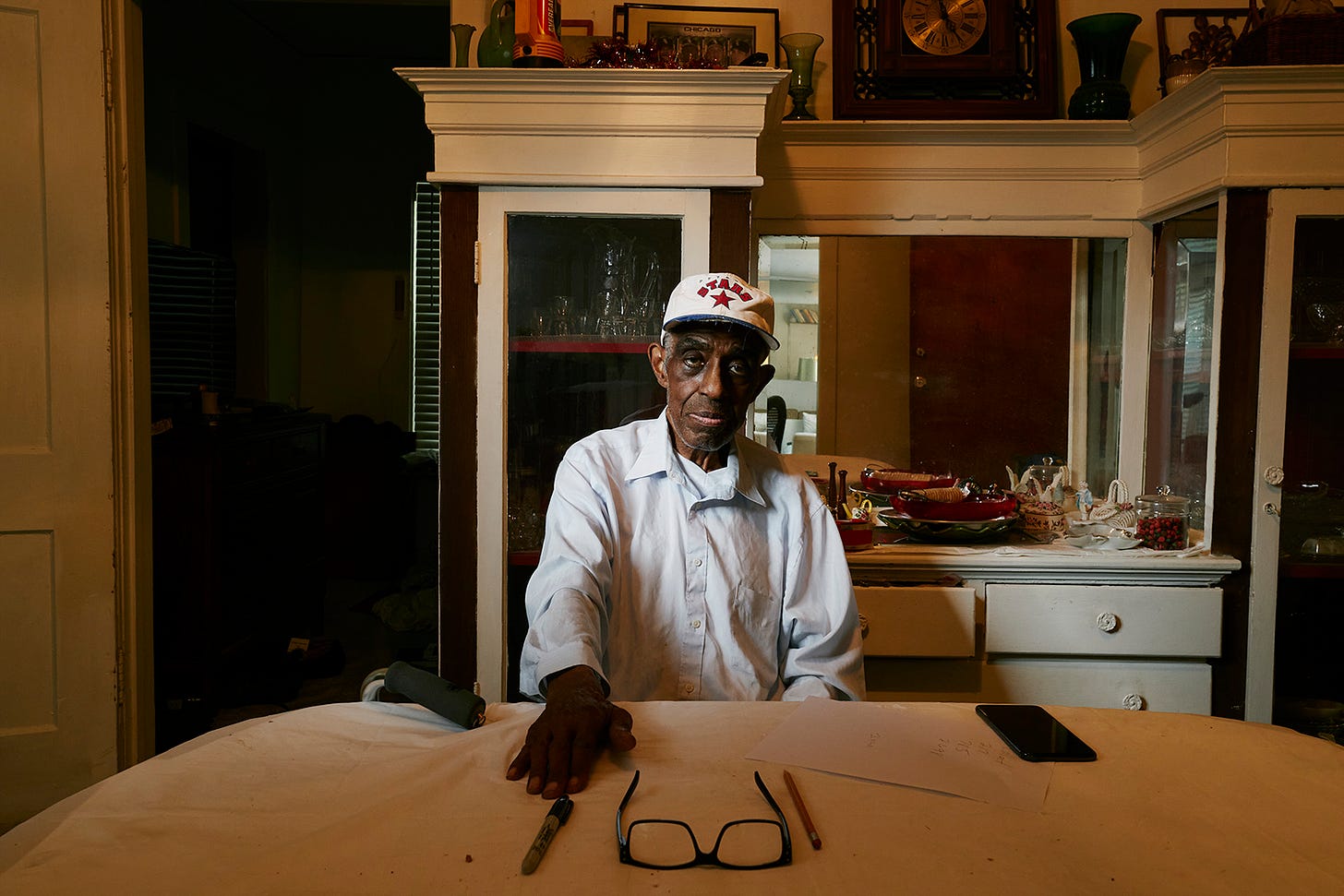
For those in Evanston, like Weathers, who have received reparations, it’s been a nice boost, but hardly life-changing. (“I could spend that money in a day,” Michael Weathers, Louis Weathers’ 61-year-old son, said of the $25,000 payment. Or, he said, laughing, “on a lady.”)
When I asked Oralene Simmons about all this, she sounded like Louis Weathers—less fired up, more philosophical. The essence of reparations, in her eyes, was not about money so much as a way of thinking.
It meant a great deal to her, she said, that when she died, she would be buried next to her great-great grandfather, on the campus of the college that once owned him and now honored him—and included, in its student body, Oralene Simmons’ granddaughter. That kind of recognition, she said, is “real power.”
She added: “That, to me, is worth something. That’s reparations.”
Adam Popescu is a writer for The Free Press. His last piece was about America’s sovereign movement.
And to support more of our work, become a Free Press subscriber today:
Also: We’re hosting our first live debate on September 13 at the Ace Theatre in Los Angeles! Has the sexual revolution failed? Come argue about it and have a drink. We can’t wait to meet you in person. You can purchase tickets now at thefp.com/debates.


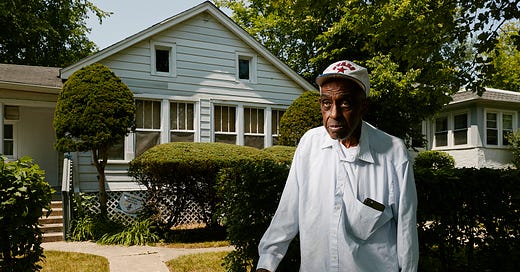


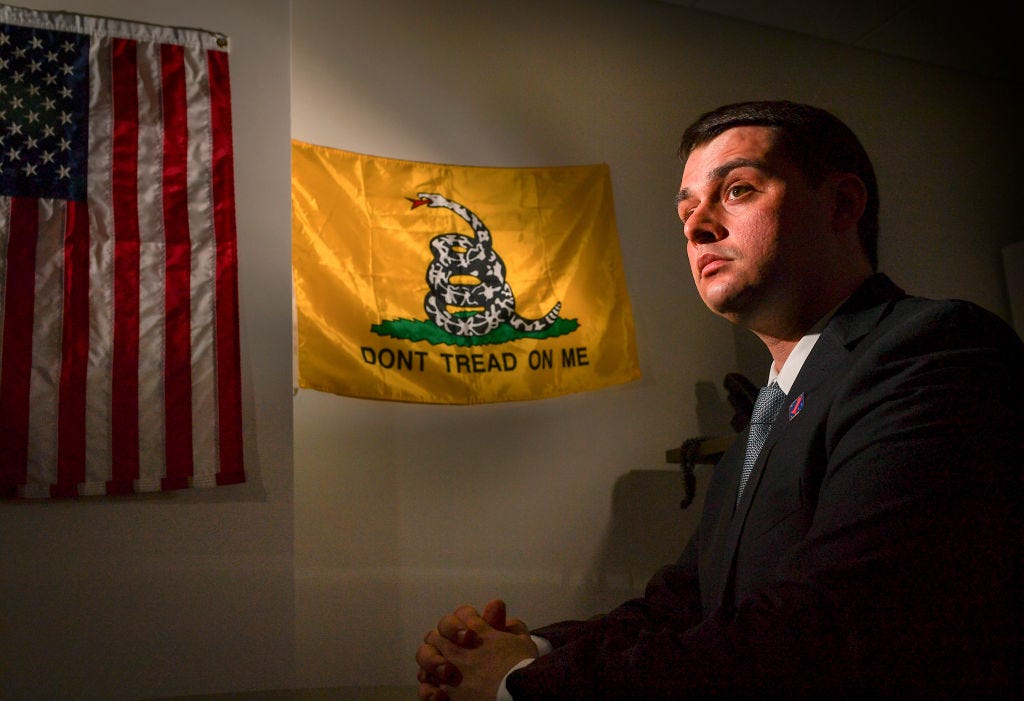



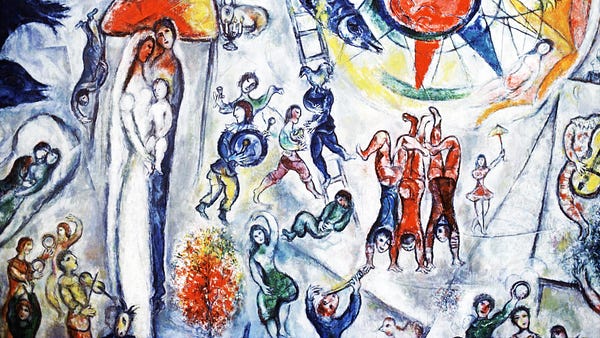



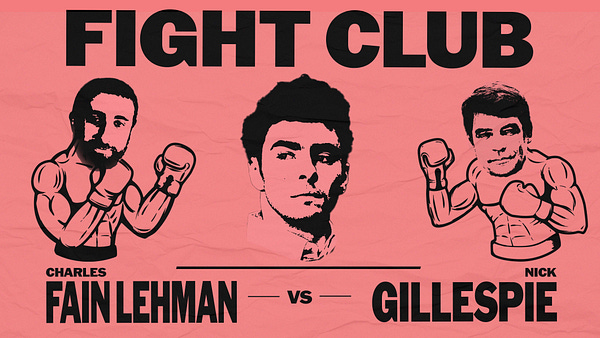

What about reparations for the descendants of all of the Union soldiers who dies during the Civil war? I wasn't a slave owner. I went to integrated schools. The people alive today should not be held responsible for what happened more than 150 years ago. White guilt!
Now that the Obamas are finishing their third mansion, this one on three acres of Pacific Ocean paradise so they can travel unimpeded from the other mansions at Martha's Vineyard and DC. , would someone tell me if these are reparations.. It just seems a little strange that Oprah who made her fortune giving away appliances to white suburban women, twelve of the richest rappers, the NBA players, most of the NFL players should take the lead to matching grants for "reparations". Maybe then reparations would have more impact than what the average lottery winners achieve after three years. And, so long as the author's poster boy (may his soul rest in peace) was a convicted felon, caught in a crime, with three times the lethal level of fentanyl in his system when he died, there is little hope that reparations will inspire from his life any achievement.